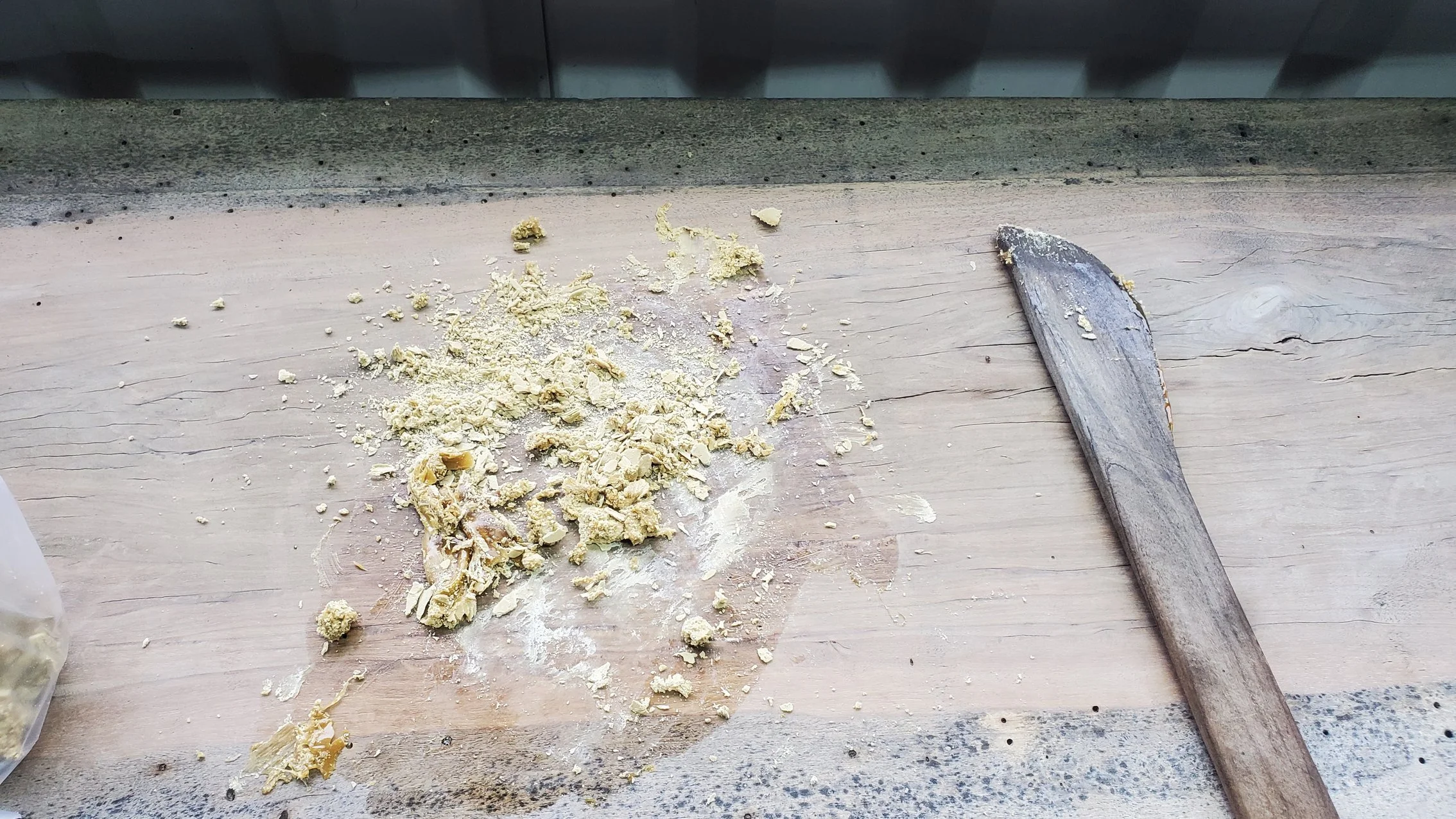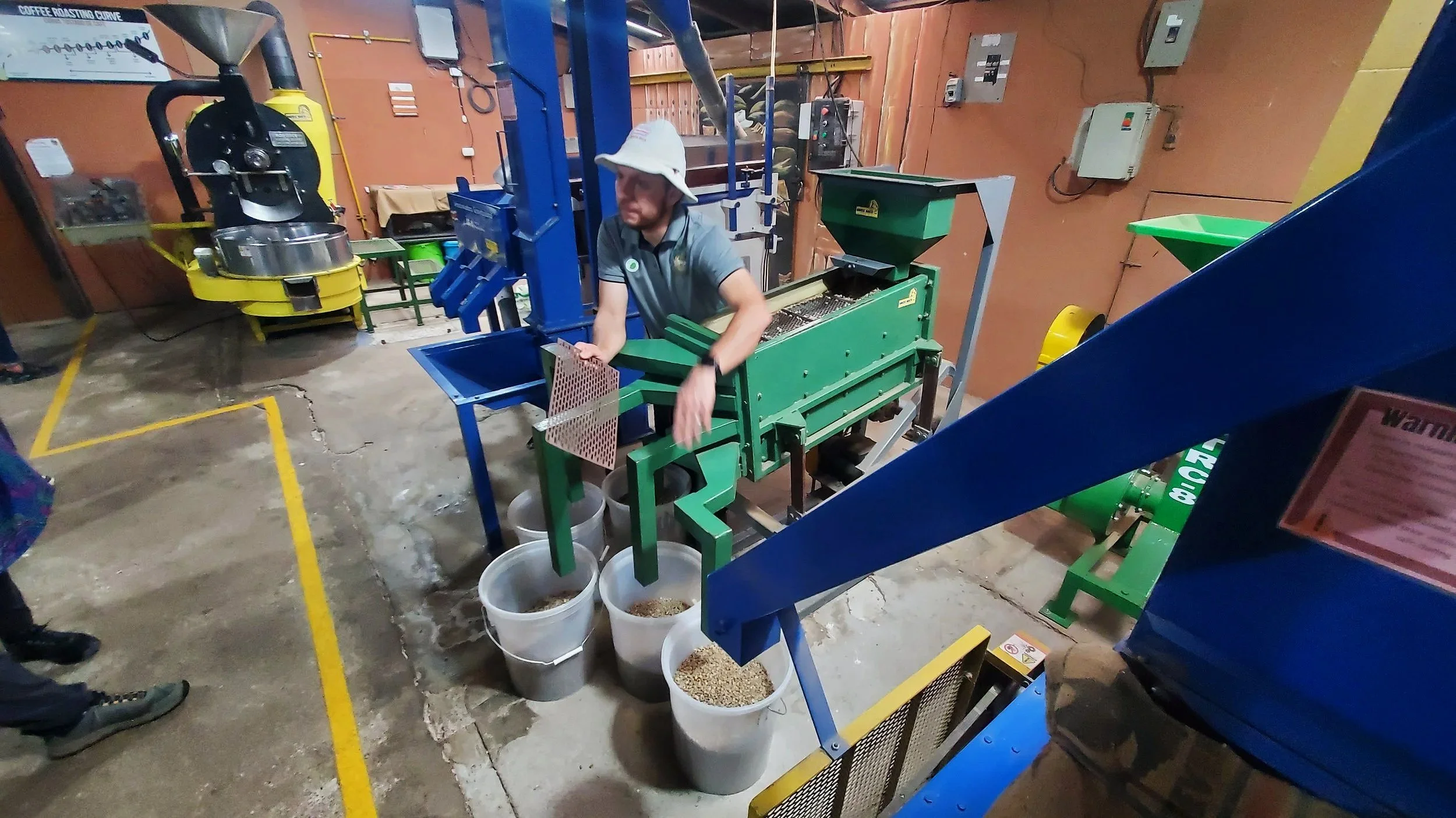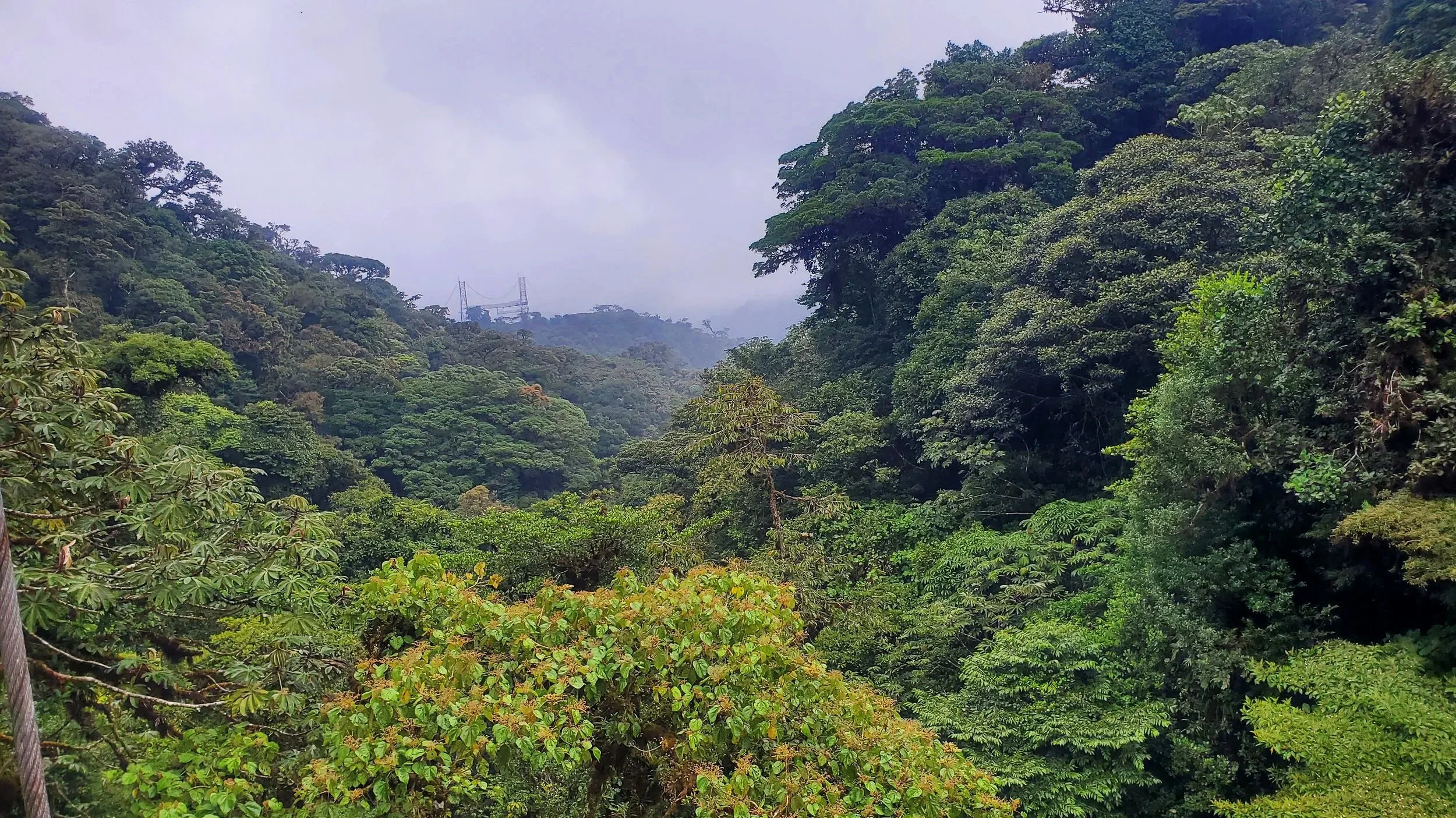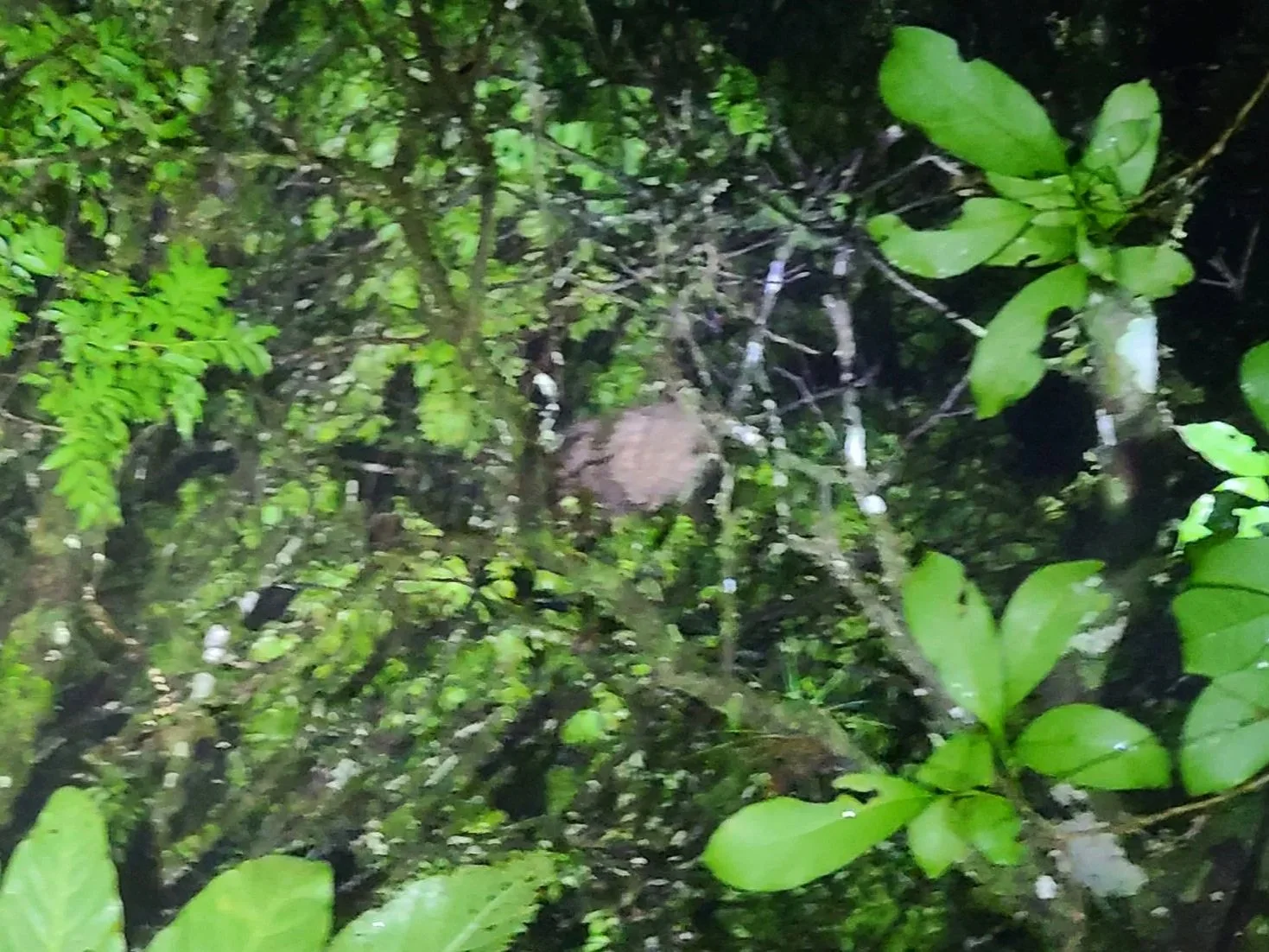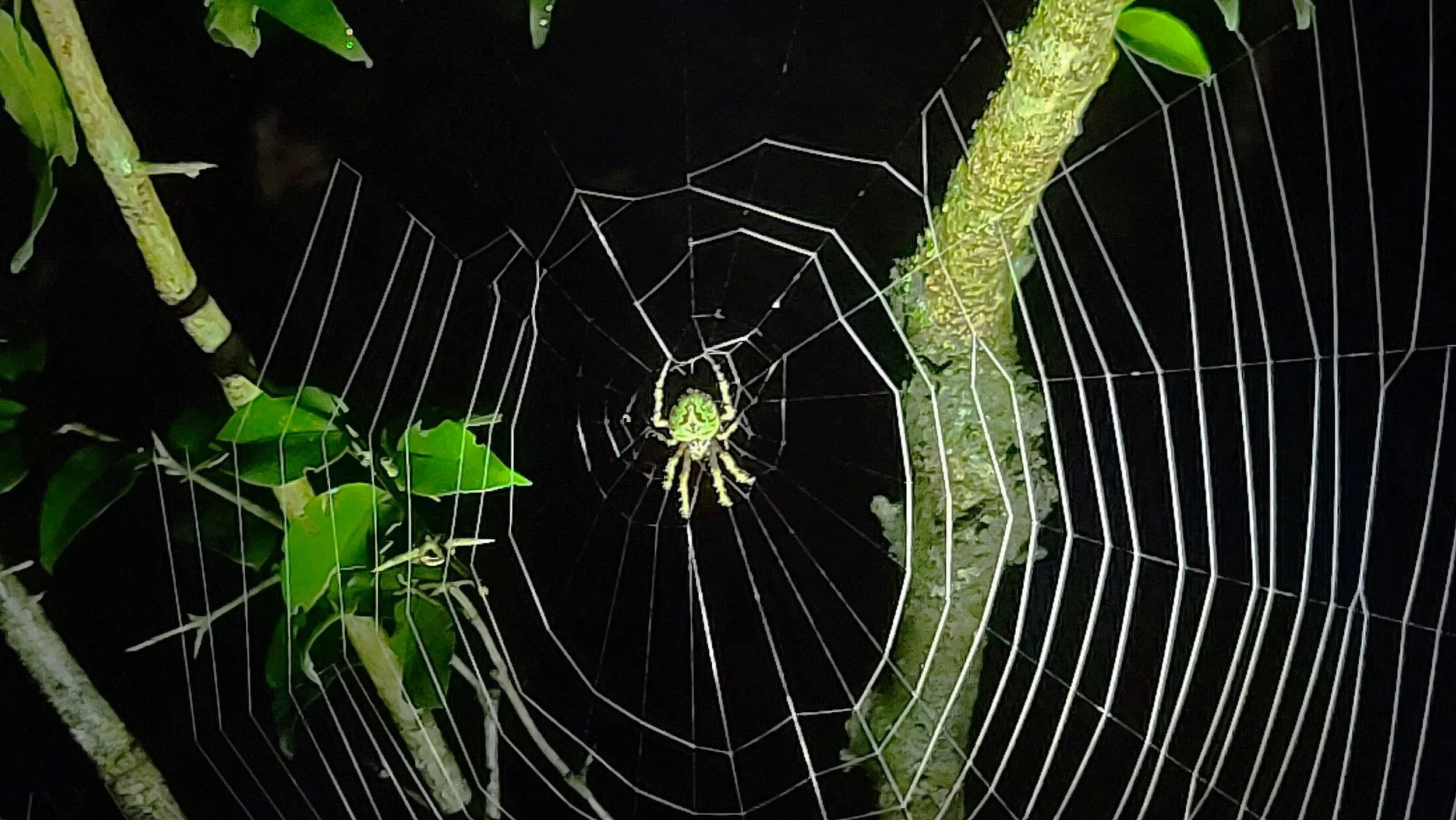I Spent a Week in the Jungle with Strangers — Part 2
10 minute read
DAY 3
Our time in La Fortuna was a dream – the Rancho Margot Farm inspires me, the Arenal volcano and La Fortuna waterfall leave me in awe, and whitewater rafting and hot springs both perfectly capture the vibes so far.
But now we’re headed to the Cloud Forest. We say, “¡Gracias! ¡Adiós!” to our hosts at Rancho Margot and pile into the bus. Daya tells us the ride is two-and-a-half hours long, but the group knows by now that means it’s closer to three! Either way, we’re headed to Monteverde.
The Tilarán Mountains (Cordillera de Tilarán) split Costa Rica in two — the Caribbean side and the Pacific side. La Fortuna is on the Caribbean side, but the rest of our trip will be on the Pacific side. Daya says there’s usually more rain on the Pacific side, but I’m not too worried about it.
Halfway through the bus ride we stop at Café & Macadamia for a break – but also for amazing views over Arenal Lake. A few people order delicious-looking baked goods, and I try a bite of the best banana bread I’ll ever have.
Back on the bus, not five minutes later we spy toucans flying overhead! Their yellow beaks are (almost) as big as their bodies, and Randall pulls over for us to get a quick look.
Monteverde
Monteverde – meaning “green mountain” – is known for its lush greenery, and it reminds me of past trips in West Virginia and North Carolina. As we crawl in elevation in the stick-shift van, we’re soon immersed in a dense fog. Here, it’s the rainy season all months of the year except for March and April. Daya says on a rare clear day you can see the Pacific ocean 30 miles away.
We finally arrive at Historias Lodge, and the whole building is covered in vegetation. The first thing we see stepping off the bus are jade vines sprouting beautiful turquoise flowers. On the way to Zach’s and my new room, I find rosemary and mint, and grab some pieces to chew on.
In our new room, Cabin 23, there’s beautiful murals and huge windows. Outside, hazy hills loom overhead. We’re not very close to the other rooms, but we’ve got a yard!
For lunch we head to Taco Taco for quesadillas, where we watch the fog literally “pour” in from the windows into the restaurant – the building across the street can’t even be seen! After lunch, we climb back on the bus for a farm tour.
El Trapiche Tour
El Trapiche offers sugarcane/coffee/chocolate tours, and it’s here we meet our tour guide, Diego, who runs the fourth-generation family business. With a straight face, Diego rattles off a few facts because there’s a test at the end – it takes us longer than it should to realize there’s no test!
Sugarcane
We first learn about caña de azúcar (sugarcane). The same family as bamboo, the sugarcane has nodules that sprout new shoots when planted. The workers harvesting sugarcane must wear high boots and long gloves — snakes hide out near the plants!
The tour becomes interactive — Diego passes out stalks of raw sugarcane for us to crunch on and suck out the juice. Then he walks us over to another way of crushing the stalks to release the juice – a wheel mechanism designed for an ox to walk in a circle. He asks if anyone wants to try it. Zach, 24 and fresh out of the US Coast Guard, gives it a shot. The wheel barely budges, and only after kicking off his flip-flops can he push it around one time!
But as you probably already know, the demand for sugar never stops. So Diego turns on a huge water-powered hydraulic wheel, demonstrating how sugarcane juice can be extracted in bulk. No effort by anyone required here!
On a large scale, the used-up sugarcane stalks pile up quickly. Luckily there’s an eco-friendly solution for this; the stalks are shredded into pulpy fibrous material called bagasse and remade into bio-degradable food packaging and tableware.
For a treat, Diego's brother heats up some sugarcane juice, stirring it until all the moisture evaporates. Then he pours out piles onto a table, and we quickly whip the sticky syrup back and forth with a wooden stick. Eventually the mass cools and crystallizes into light brown chunks of natural sugar. I don’t love sweets, but I’ll happily take it home as a natural sweetener.
Another product of the sugarcane juice is guaro, a homemade spirit. I joke it’s “the moonshine of Costa Rica,” but Maria, from Germany, is unfamiliar with the term. Zach explains how Americans used to make illegal alcohol in the dark woods under the light of moonshine.
Coffee
Coffee is one of Costa Rica’s largest exports, but Diego’s son tells us it’s only 0.6% of the world's coffee production! They show us los cafetos (coffee trees), which produce coffee for up to 80 years! The trees grow fairly tall, but they’re pruned so all the coffee fruit can be harvested from the ground.
The coffee fruits, known as “cherries,” are ripe when they turn from green to red, where it's then tediously hand-harvested. Most pickers, at $6/basket, fill a 28 lb basket in an hour. We equip Sophia with a basket, and she starts picking, but she’s slow and gets rebuked for a few green cherries! Daya recalls a few of her childhood days spent picking the fruit, and she remembers that it was not fun.
Once the fruit is picked, there’s three ways to process los granos de café (coffee beans).
In the natural (traditional) process, the fruit is sun-dried before separating the fruit from the bean. This allows the beans to absorb the flavor and have a full-bodied, fruity taste. This becomes a “specialty” coffee, and makes up about 30% of El Trapiche’s coffee production.
The honey process, proceso miel, removes the fruit before sun-drying, but there’s still some sticky residue present (hence the “honey” part). These beans dry faster and yield a more balanced, consistent taste.
Lastly there’s the washed process, proceso lavado, where the separated beans are just washed with water and dried – this is most commercial coffee, and although it lacks the flavor of the natural or honey process beans, it’s much easier and cheaper to produce.
People Love Coffee
The biggest surprise? Costa Rica actually imports coffee! Costa Rican farms export their best coffee to buyers from around the world, leaving the locals with what’s left… But I’m told Ticos (Costa Rican natives) grew up with it like that, and that's what they know and love.
Traditional method for extracting coffee beans
Modern method for extracting coffee beans
Diego then demonstrates the traditional way of separating the seed from the shell via mortar and pestle. I give it a try as well, and it’s as grueling as it looks – but that isn’t necessary anymore with machines, and it’s easy enough for Sophia to simply turn a wheel.
Coffee bean sorting machine
Normal coffee beans are oval shaped with a flat side, but sometimes a fruit will have one or three beans inside instead of the normal two. About 5–10% of a harvest has single-beans, and 1% or less with three beans.
The single beans, called peaberries, are small, round, and sorted in the first pass. They’re more dense and uniform in size, roast more consistently, and are highly desired for their smooth taste.
Coffee bean roasting
Medium-roast coffee is what connoisseurs prefer, since that yields the best balance of flavor. Dark roast is sold commercially because the longer heating process masks undesirable qualities of the coffee beans! As for caffeine, he says the caffeine content depends on the time the hot water is in contact with the bean more than the roast of the bean itself.
The finished product is then poured, taste-tested, and rated on a scale from 1–100. Eighty or higher is considered specialty coffee, and El Trapiche usually scores in the mid 80s. Diego tells us one type of coffee from Panama, scoring a 98/100, recently sold a 44 lb batch for $604,080. Once brewed, that’s almost $600 for one cup of coffee!
I know people love their coffee, but that’s insane!
Cacao
Lastly, we learn how to process cacao beans into chocolate. Monteverde growing conditions aren't ideal for la planta de cacao, so we walk inside a greenhouse to see one. Diego tells us cacao trees can be hard to maintain, since animals love chocolate just as much as humans do!
He chops open a cacao pod (mazorca de cacao) and inside the beans are covered in white gooey pulp. He gives us all a piece to suck on, but I don’t love the texture – I learn it’s after they ferment in this pulp that the beans develop their chocolatey taste.
For the third (and final) workout of the tour, Maria hops on a bike to crush up the cacao for processing.
From here, the cacao beans are processed for nutrition or flavor. To preserve their nutrition, the beans are cold-pressed at a low temperature, which separates into cacao butter and cacao powder. For flavor, the cacao beans are first roasted to unlock their world-renowned flavor. Once pressed, you get cocoa butter and cocoa powder.



Concluding our tour, we head to the kitchen for samples. First I try the honey process, first pass (peaberry) coffee. I prepare for the familiar bitterness, but there is none –the black coffee is smooth. Isabelle agrees and says there’s not even a hint of harshness to it. I also enjoy some espresso and a splash of guaro.
But my favorite is what the Mayans called the “drink of the gods” (xocolātl). The little sip from the tiny mug is made from cacao powder, hot water, cinnamon and chili. Between all the drinks, I leave feeling like I can race Randall back to the hotel!
Our group’s tour took three hours instead of the normal two, but it was one of my favorite things to do so far in Costa Rica. Tours like this are grounding because for many (dare I say most) people, it’s not often they get to talk to the farmers who grow their food. In tours like this, you get a feel for the type of energy the farmer puts into their livelihood, and by extension, your food!
Diego is knowledgeable, funny, and passionate about his family’s business. In the shop I buy a bag of Natural Process Medium Roast Specialty Coffee for my parents. Those who didn’t go on the tour hear all about it, and it sparks a competition of who can see and do the coolest things on the trip.
food is energy
Food is energy, and the quality and integrity of that energy is the difference between health and sickness. One can talk about healthy living all day, but it’s consistently making healthy choices, day after day, that inspires others. Let food be thy medicine, and medicine be thy food.
Additionally, knowing the resources that go into growing your food empowers healthy, conscious living. In a way, knowing yourself becomes knowing your farmer. If more people advocate for organic farming and holistic ways of living, eliminating sickness becomes not just a vision, but reality.
When it comes to my soap, lip balm, deodorant, and other all-natural (almost) edible products, I’ve done the research – the coconut oil is fair-trade, the olive oil is extra-virgin, first-pressed, cold-pressed, tallow is 100% grass-fed grass-finished, and beeswax is locally sourced. I only use minimally-processed ingredients, sustainably and organically made to preserve the life-giving properties your body deserves.
The sky glows red-gold and the air cools — the start of a beautiful night. We leave the farm behind and head to dinner.
Late Night in Monteverde
It’s a Tuesday night, so nightlife is pretty dead. After dinner, me, Zach, Grace, Michael, Chris, Sophia and Sam get dropped off at Bar Amigos. The bar is pretty big, but we try our best to fill up the space with dancing. Meandering Monteverde at night, we eventually make our last stop of the night at Natu speakeasy, accessible only through a freezer door!
It’s a late night for Grace, Michael, Zach, Sophia and I as we toss flow stars in the air like pizza pies in the small yard. I spot an armadillo running through the wet grass, but he’s way too fast for a picture. We look up and marvel at a shooting star streaking across the sky, our wishes for an amazing trip having already come true.
DAY 4
On our way to breakfast, Zach and I walk out of our room and see a rabbit-like animal in the yard. I know it’s not a capybara, but that’s what I call it when I tell Daya about our sighting. She tells us they’re called agoutis.
I order the typical breakfast of rice, beans, fresh fruit, fried plantains, and a slice of cheese. Some people don’t love papaya, so I end up eating everyone’s papaya as well – the melt-in-your-mouth experience just tastes too good!
Treetopia
Today we’re headed for an adrenaline rush – ziplining and hanging bridges. We pull up to Treetopia, and right away someone’s screaming their head off in the air above us. It looks fun, but also kind of scary!
Once we’re suited up with a harness, gloves, and a helmet, we take a “practice” zip line over to the cable cars. Then the open-air cable cars take us on a ride up to the top of the mountain. The views are amazing, so we climb a few extra stairs to take pictures.
I only know how to speak English, but I’m attempting to learn some Spanish on this trip via phrases of speech. On the ride up, an employee teaches me “¿Por qué no?” a Spanish form of YOLO!
Zip Lines
I hook in to the first zipline, yell “¡Pura Vida!” and glide hundreds of feet over the forest canopy. It’s an exhilarating feeling, and you can see greenery for miles around. The trees look like huge balloons, all eager to grab the best rays of sunlight.
While waiting for the others to zip across, I look at a tree and see the fractal patterns of life in plain sight. Different types of plants climb all over one another, and numerous species of life can be found on a single branch. Each tree seems to host its own world, and I wonder how many worlds make up the trees.
We’re told that to reach the end of one of the ziplines we need more weight — that means doubling up! We laugh as we choose our partners and wrap our legs around each other for a few moments of exhilaration!
With only three ziplines left, it starts raining. We go faster on the ziplines now, but there’s a trade-off… As we unhook from the wet zipline, we’ve got mud (and hopefully not monkey poop) splattered on us!
After the last zipline, we hook into a different mechanism for the next rush – the monkey drop! I’m second in line, and while Grace is bouncing with excitement, I’m still coming to terms with fate. (Nervously) I jump backwards from the platform 79 feet in the air. I don’t know what’s normal, screaming or not screaming, but I’m sure some of us are heard from far away.
Hanging Bridges
A coati, a type of raccoon, runs through some dense bushes as we approach the hanging bridges trail. Daya says she’s looking for snakes, so I let her take the lead. The five free-swinging bridges over wild, untamed jungle don’t involve a harness, but they still look suspicious.
Each person adds an unpredictable sway to the bridge, and it’s challenging enough just keeping my balance on the bouncing platform. We’re a hundred feet above the forest floor, and I carefully jam my phone into my pocket, nervous about forever losing it to the jungle floor.
Chris and I are busy taking pictures when we suddenly hear – and feel – a big thud. Somewhere a tree just fell! There’s huge trees all around, and I can only imagine how big that one was. We meet Grace back at the bus, headed for lunch, and she shows me a video she took at the same moment of the falling tree. I tell her the moment was meant to be.
Night Tour
After lunch, I relax in bed for only an hour before our next event- the night walk tour. My parents told me not to go on a night walk tour, since on their trip they casually stepped over a venomous snake. The jungle at night gave them a good spook, and at that point, they insisted their tour end early.
But really — what am I gonna do on my trip to Costa Rica, skip the night walk?
Around 6pm, just after sundown, we arrive at Kinkajou Night Walk Tour. We split into two groups, and our new leader, Jairo, gives us the rundown of how we’re going to search for animals. We appoint two people to take pictures for the group, me and Danielle, and we start marching.
Fifty yards past the building – before we even reach the woods – we see some commotion going on. There’s a kinkajou running through a tree! We’re told kinkajou sightings are rare, and being on a tour called the Kinkajou Night Walk, 10 seconds out of the gate, it feels synchronistic. Although I’m unprepared for the sudden action already, I’m able to get this picture of the cat-like animal crawling through the branches.
From there we turn right. Jairo starts ribbiting, and I crack a smile, half-ready to join him. Then I start laughing as we hear someone ribbiting back! The calls go back and forth until we spot the male frog in a small pond, who’s not expecting seven humans to put him on full blast!
I have no idea the degree other animals will be out and about tonight, so I’m on high alert, especially considering my parents’ forewarning. We each have our own flashlight, and as we enter the woods, I aim mine at everything close to where I'm walking.
The danger of the jungle at night becomes immediately obvious once we find a pit viper! This one’s a juvenile, but still not to be messed with. The green snake is coiled around the base of a tree, ready to snatch any little pest off the rainforest floor.
One of the other guides spots a sloth, so we run over, eager to see the first sloth of the trip! It’s not an amazing sight though – he’s 50 feet up in the tree, and his slow-moving brown body is hard to see – but I got a picture of him nonetheless. We continue on, eager to find who-knows-what else.
We find stick bugs, spiders, and some small frogs, one who blends in so well it’s hard to see him at all. A glass frog, barely bigger than a fingernail, seems to pose for us as we check him out.
Looking up in the trees, Jairo finds toucans and other birds perched on branches falling asleep (or at least trying to).
The two hour tour flies by, and as we emerge from the woods, we spot one last little critter – a scorpion. He’s a small guy as well, an inch long at best. Jairo tells us every known scorpion in the world is UV reactive, as shown by the UV light we shine on this guy. While trying to get a good picture of the scorpion, he crawls away out of sight – but we have to hurry up and find him, because the group right behind us wants to see him too!
We meet back up with the rest of our group, and Daya says that’s the best night tour she's ever done! Our groups talk about the different animals we saw, and Grace (who didn’t attend the El Trapiche farm tour) tries convincing us they saw way cooler animals than our group did! Sometimes people forget that a whole new world wakes up when the sun goes down, and this night walk tour clearly highlighted that fact.
I’m so grateful we’ve seen such a wide range of plants and animals on our trip so far, each one unique in its own way. It’s the perfect way to end our last night in Monteverde.
DAY 5
The group is learning more about each other’s quirks and forming bonds over common interests, one of the most basic but powerful things one can do to foster a happy life. Everyone has a story about the obstacles they’ve faced in life and the steps they’ve taken to improve themselves, and it leads to greater perspectives about how we overcome the challenges we face, both individually and as a group.
This morning we pack up for our final destination of the trip –Manuel Antonio. The trip has been amazing so far, and it’s only getting better from here. Manuel Antonio is located on the Pacific coast, and they don’t call it Costa Rica – the “Rich Coast” – for nothing!
A highly anticipated catamaran boat ride is almost upon us, and with ocean sunsets ahead, I’m already in love before we even get there…
Continue to PART 3
Follow me on Instagram:













